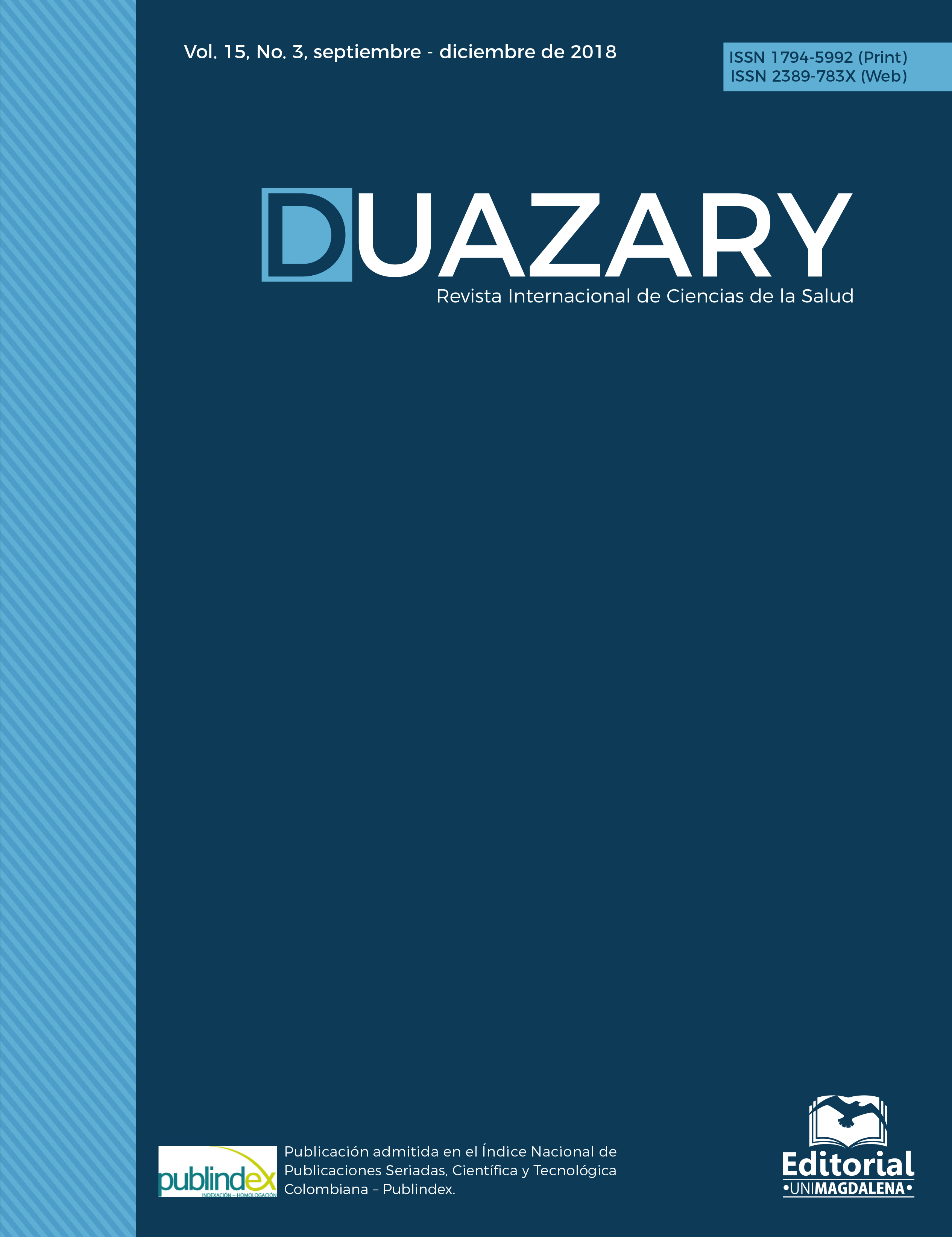Influence of using hydrochloric acid for measuring the concentration of total carnitine in human plasma by Tandem mass spectrometry
Contenido principal del artículo
Resumen
El presente estudio establece, si el pH al cual se procesan las muestras, condiciona la determinación de la carnitina total en plasma, mediante el uso de espectrometría de masas en tándem; así mismo analiza, si es necesario neutralizar las muestras luego de la hidrólisis alcalina de las acilcarnitinas. Carnitina libre y total de 10 muestras de plasma fueron medidas mediante el ensayo radioenzimático, como método de referencia. Posteriormente fueron medidas cinco veces cada muestra, mediante espectrometría de masas en tándem utilizando ácido hidroclorhídrico y sin usar ácido hidroclorhídrico. Las concentraciones de carnitina libre y total, fueron similares utilizando ensayo radioenzimático y espectrometría de masas en tándem. No se encontró diferencias significativas entre las dos variables analizadas (con ácido hidroclorhídrico, o sin ácido hidroclórhídrico). Puede concluirse que el pH de las muestras no es crucial para medir carnitina total en plasma por espectrometría de masas en tandem y no es necesario neutralizar las muestras luego de la hidrólisis alcalina de las acilcarnitinas. El método más corto puede ser utilizado para tal fin.
Descargas
Detalles del artículo
No se permite un uso comercial de la obra original ni de las posibles obras derivadas, la distribución de las cuales se debe hacer con una licencia igual a la que regula la obra original.
Citas
2. Tein I. Disorders of fatty acid oxidation. Handb Clin Neurol. 2013; 113:1675-88.
3. Wajner M, Umpierrez-Amaral A. Mitochondrial dysfunction in fatty acid oxidationvdisorders: insights from human and animal studies. Bioscience Reports. 2016; 36: e00281.
4. Osorio-Orozco JH, Pourfarzam M. Diagnostic error of mental retardation of neurometabolic origin confirmed by mass sequential spectrometry. Rev Neurol. 2000; 30(8):728-30.
5. Ostermann KM, Dieplinger R, Lutsch NM, Strupat K, Metz TF, Mechtler TP, et al. Matrix-assisted laser desorption/ionization for simultaneous quantitation of (acyl-)carnitines and organic acids in dried blood spots. Rapid Commun Mass Spectrom. 2013; 27(13):1497-504.
6. Peng M, Liu L, Jiang M, Liang C, Zhao X, Cai Y, et al. Measurement of free carnitine and acylcarnitines in plasma by HILIC-ESI-MS/MS without derivatization. J Chromatogr B Analyt Technol Biomed Life Sci. 2013; 932:12-18.
7. Millington DS, Chace DH. Carnitine and acylcarnitines in metabolic disease diagnosis and management. In: Desiderio DM editor. Mass spectrometry: clinical and biomedical applications. New York: Plenum Press; 1992. p. 299-316.
8. Johnson JV, Lee MS, Lee MR, Yost T. Triple Quadrupole MS/MS in Biomedical Research. In: Gaskell SJ, editor. Mass Spectrometry in Biomedical Research. John Wiley & Sons; 1986. p. 459-457.
9. Rashed MS, Bucknall MP, Little D. Screening blood spots for inborn errors of metabolism by electrospray tandem mass spectrometry with a microplate batch process and a computer algorithm for automated flagging of abnormal profiles. Clin Chem 1997; 43(7):1129-1141.
10. Kodo N, Millington DS, Norwood DL, Roe CR. Quantative assay of free and total carnitine using tandem mass spectrometry. Clin Chim Acta 1989; 186:383-390.
11. Osorio JH. The analysis of carnitine and acylcarnitines by tandem mass spectrometry. Master of Philosophy Thesis. University of Newcastle upon tyne. 2004. P36.
12. Opalka JR, Gellerich FN, Zierz S. Age and sex dependency of carnitine concentration in human serum and skeletal muscle. Clin Chem. 2001; 47(12):2150-3.
13. Moorthy AV, Rosenblum M, Rajaram R, Shug AL. A comparison of plasma and muscle carnitine levels in patients on peritoneal or hemodialysis for chronic renal failure. Am J Nephrol. 1983; 3(4):205-8.
14. Nadaoka I, Hatakeyama E, Tanada C, Sakamoto T, Fukaya S, Akiba T, et al. Quantitative determination of total L-carnitine in infant formula, follow-up formula, and raw materials by liquid chromatography with tandem mass spectrometry. Anal Sci. 2014; 30(8):839-44.
15. Savica V, Calvani M, Benatti P, Santoro D, Monardo P, Mallamace A, et al. Newer aspects of carnitine metabolism in uremia. Semin Nephrol. 2006; 26(1):52-5.
16. McGarry JD, Foster DW. An improved and simplified radioisotopic assay for the determination of free and sterified carnitine. J. Lipid. Res. 1976; 17(3):277-81.
17. Osorio JH, Pourfarzam M. Plasma free and total carnitine of children measured by tandem mass spectrometry. Bras J Med Biol Res. 2002; 35:1265-71.
18. Cederbland G, Lindstedt S. A method for the determination of carnitine in the picomole range. Clin Chim Acta. 1972; 37:235-43.
19. Cederblad G, Harper P, Lindgren K. Spectrophotometry of carnitine in biological fluids and tissue with a Cobas Bio centrifugal analyzer. Clin Chem. 1986; 32(2):342-6.
20. Lepage N, Aucoin S. Measurement of plasma/serum acylcarnitines using tandem mass spectrometry. Methods Mol Biol. 2010; 603:9-25.
21. Osorio JH, Pourfarzam M. Hydrolysis of acylcarnitines during measurement in blood and plasma by tandem mass spectrometry. Acta Bioquím Clín Latinoam. 2010; 44(2):189-93.
22. Sewell AC. Methods of carnitine analysis. In: Seim H, Löster H, editors. Carnitine-Pathobiochemical Basics and Clinical Applications. Bochum: Ponte Press; 1996. p. 73-84.
23. Naylor EW, Chace DH. Automated tandem mass spectrometry for mass newborn screening for disorders in fatty acid, organic acid, and amino acid metabolism. J Child Neurol. 1999; 14(Suppl 1): S4-S8.
24. Osorio JH. Effect of acetonitrile concentration on acylcarnitines measurement by tandem mass spectrometry. Biosalud. 2010; 9(1):9-16.
25. Osorio JH, Pourfarzam M. Effect of adding the internal standard to blood samples, prior to the preparation of blood spots for acylcarnitine analysis. Biosalud. 2010; 9(2):14-20.
26. Wilcken B, Wiley V, Hammond J, Carpenter K. Screening newborns for inborn errors of metabolism by tandem mass spectrometry. N Engl J Med. 2003; 348:2304-12.
27. Osorio JH. Effect of anticoagulant type during the blood sample collection process on the determination of the acylcarnitine profile in blood and plasma. Biosalud. 2010; 9(2):9-13.

